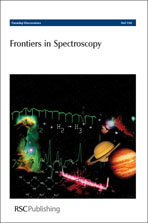Quantitative vibronic coupling calculations. The visible spectrum of propadienylidene
Abstract
High-level ab initio calculations that employ the equation-of-motion coupled-cluster method in the singles, doubles and triples approximation (EOMEE-CCSDT) have been used in conjunction with a quasidiabatic ab initio approximation to construct a vibronic Hamiltonian for the strongly coupled Ã1A2 and ![[B with combining tilde]](https://www.rsc.org/images/entities/i_char_0042_0303.gif) 1B1 states of
1B1 states of ![[B with combining tilde]](https://www.rsc.org/images/entities/i_char_0042_0303.gif) 1B1 origin. Despite the fact that a great number of individual vibronic levels contribute to each major band in this higher energy region, the spectrum is qualitatively similar to that from a Franck–Condon treatment, apart from a consequent broadening of the features. By contrast, the range from 15 800–16 500 cm−1, which comprises the
1B1 origin. Despite the fact that a great number of individual vibronic levels contribute to each major band in this higher energy region, the spectrum is qualitatively similar to that from a Franck–Condon treatment, apart from a consequent broadening of the features. By contrast, the range from 15 800–16 500 cm−1, which comprises the ![[B with combining tilde]](https://www.rsc.org/images/entities/i_char_0042_0303.gif) 1B1 ←
1B1 ← ![[X with combining tilde]](https://www.rsc.org/images/entities/i_char_0058_0303.gif) 1A1 origin, is profoundly affected in appearance by the vibronic interaction. The simulations do a credible job of accounting for the spectrum in this region, although a thorough analysis of all features cannot be made at this time. A combination of ab initio calculations, experimental observations and the spectral simulation allows an estimate for the position of the (electric dipole forbidden) Ã1A2 ←
1A1 origin, is profoundly affected in appearance by the vibronic interaction. The simulations do a credible job of accounting for the spectrum in this region, although a thorough analysis of all features cannot be made at this time. A combination of ab initio calculations, experimental observations and the spectral simulation allows an estimate for the position of the (electric dipole forbidden) Ã1A2 ← ![[X with combining tilde]](https://www.rsc.org/images/entities/i_char_0058_0303.gif) 1A1 origin: 13 600 ± 200 cm−1.
1A1 origin: 13 600 ± 200 cm−1.
- This article is part of the themed collection: Frontiers in Spectroscopy

 Please wait while we load your content...
Please wait while we load your content...